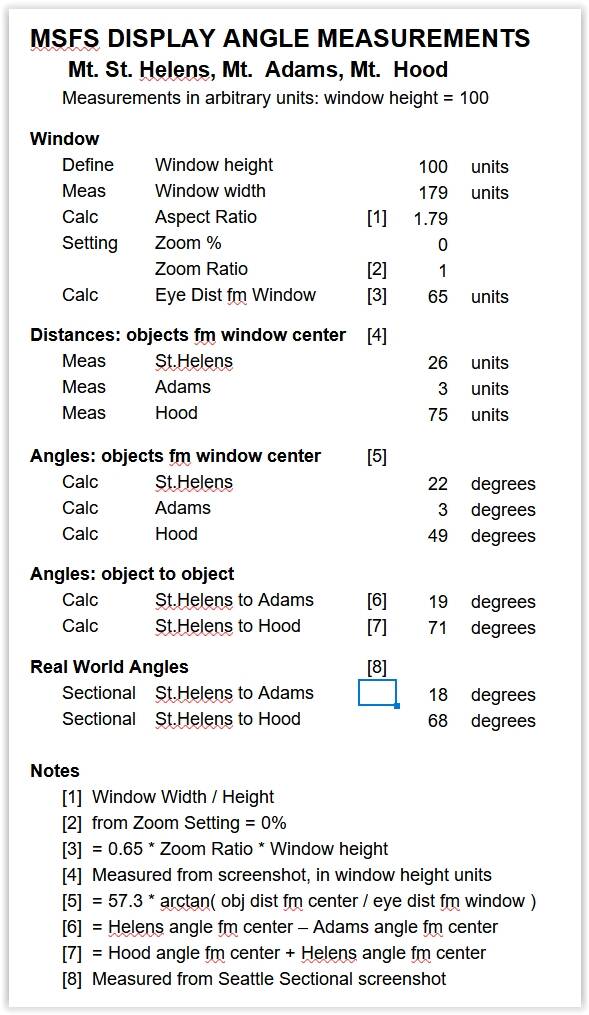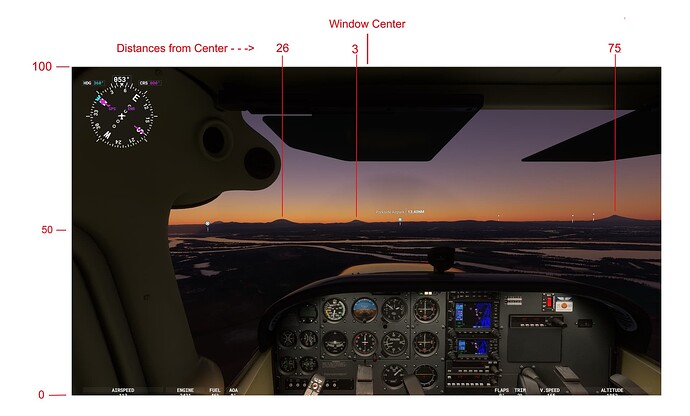My first impression of the MSFS display was – wow, this really is wide angle! Now I’m not so sure.
There was a post “Major pincushion distortion on screen as default? - VFR (anything with looking out of the cockpit) flying is unrealistic in MSFS by concept?” plus extensive discussion. I suggest another way of thinking about it.
First, I needed a quantitative, measurable definition of “wide angle” – wider than what? I took “natural” angles to mean the angles the unaided eye sees between objects. But looking at an image of the same objects on screen, angles between objects depend on how far the eye is from the screen, so the concept of wide angle becomes meaningless & needs more definition.
In the MSFS display, the scenery is progressively stretched toward the screen edges.
ASSUMPTION: When viewed from a specific distance of eye from screen center (call it “SED” for short), the image of an object will appear the same size (subtend the same angle at the eye) from anywhere on the screen.
IF this is true, then SED is approx. 0.65 * Zoom Ratio * display window height. Here Zoom Ratio is the size of objects in the “zoomed” display (Zoom > 0%) to their “unzoomed” size (Zoom = 0%). This is NOT the same as Zoom %. See my post: “Zoom Ratio vs %”.
For a typical laptop 17”, 16:9 screen with Zoom = 0% (Zoom Ratio = 1), it’s around 5.5”. For Zoom = 50% (Zoom Ratio = 1.64) SED is around 8.5”.
Viewed from SED, the display is what would be seen looking at the real scenery through a window-sized frame. The angles encompassing the real field of view (FOV) are the same as those of the window edges. The angles between screen objects of objects would be the same as their real world angles.
If the display is WIDE ANGLE, then the real world FOV angles are larger than the on screen angles viewed from SED, & screen images of objects appear smaller. The DISPLAY is NOT DISTORTED – an object’s image still appears the same size anywhere on screen. Conversely, angles between displayed objects are less than between the same objects in the real scenery view.
If the display is viewed from an eye to screen distance larger than SED, angles are smaller, suggesting wide angle, but the display distortion is very visible.
To compare object angular separation in the MSFS display viewed from the SED vs in the real world, I ran MSFS (v 1.32.7.0) on a 17" laptop, in a convenient size window. I set Options > General Options > Camera > Cockpit Camera Selection: Wide Angle, Zoom = 0%, for Zoom Ratio = 1. I flew near Scappoose (KSPB) & used Mt. St. Helens, Mt. Adams and Mt. Hood as the objects. I took a screenshot when all were clearly visible.
I set up scale such that window height is 100 units, & used this measure the distance of each mountain from screen center. See appended screenshot of the view from the airplane, plus measured positions of the objects. The results are in the appended spreadsheet. The Notes are about where the numbers came from.
The computed angle between Helens & Hood was 71 degrees, and between Helens & Adams 19 degrees. I did the measurements again with several different window widths & heights, and zoom %, got similar results.
I measured real world angles from the Seattle Sectional chart. I’ve appended a part, with the relevant points circled, and lines from the viewpoint (KSPB). Measured angles: Helens to Hood – 68 deg; Helens to Adams – 17 deg.
This relatively close agreement suggests that the MSFS display is not wide angle, by my definition, and when viewed from the specific eye distance from screen.
1 Like
In my post I inadvertently omitted the spreadsheet showing the angle calculations & results. Sorry about that. Here it is.

This is long known problem and there is already a lot been said and written about this.
It has no priority by Asobo to solve this. The user will have to live with this distortion for a very long time to come. When someone uses a triple monitor or a ultra widescreen monitor configuration then it is a realy bad experience.
3 Likes

